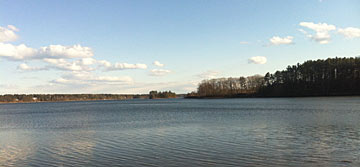The Partnership’s activities are guided by the following Land Conservation and Stewardship Goals:
Water Quality: Through land conservation and stewardship achieve and maintain the water quality and quantity necessary to support the aquatic living resources of the Great Bay and its tributaries within the coastal watershed and to protect human health.
Wetland Ecosystems and Significant Habitats: To protect, enhance, restore, and manage an appropriate distribution and diversity of wetland ecosystems and other habitats essential and significant for the protection of water quality of Great Bay and wildlife including migratory birds, fish, shellfish and other wildlife.
Migratory Bird Populations: To maintain or improve current distributions of waterfowl and other migratory bird populations, and to help maintain optimum population levels, distributions, and patterns of migration.
Exemplary Natural Communities and Habitats: To protect, enhance, restore, and mange exemplary natural and characteristic natural communities and habitats for rare, threatened, and endangered species of animals, plants, and natural communities.
Working Landscape: To protect farm and forest land that provides both important sustainable economic and ecological benefits and help ensure that these lands continue to be managed on a sustainable basis that provides multiple conservation values and supports other Conservation Goals of the Partnership.
Conservation Land Connectivity ~ To support the conservation of lands that facilitate landscape connectivity in the coastal watershed.
Climate Resiliency ~ To promote climate resiliency through the protection and management of diverse landforms that will sustain native biodiversity, connect with other conservation lands, and support habitat and wildlife migration.
Recreational and Educational Opportunities ~ To protect natural areas that are important for aesthetic purposes and provide for quality public recreational and educational opportunities that are compatible with the protection of the other Conservation Goals of the Partnership.
Conservation Stewardship ~ To manage conservation properties within a landscape perspective that respects the integrity and diversity of the entire ecosystem, promotes shared management guidelines and fosters management collaboration among conservation landowners.
Great Bay – At the Heart of the Watershed

photo by Dea Brickner-Wood
The coastal watershed of New Hampshire supports significant natural, recreational, scenic and cultural resources. The Partnership serves the 42-town NH coastal watershed, approximately 531,000 acres. The watershed has consistently been identified as one of the fastest growing regions in the state. Located in the Gulf of Maine watershed, the coastal watershed comprises 9% of NH’s landmass, and includes 9 major rivers, 12 sub-watersheds and 2 estuaries of national significance. The 18-mile NH coastline increases to 150 miles when tidal shoreline of Great Bay Estuary is included.
At the heart of the watershed is Great Bay, a widely recognized estuarine ecosystem of local, regional, state and national significance. The Great Bay estuary has been designated a conservation priority by the National Estuarine Research Reserve, Important Bird Area, N.H. Wildlife Action Plan, North American Wetland Conservation Plan (International Focus Area), and the U.S. Environmental Protection Agency’s N.H. Resource Protection Project. The inland location of the Great Bay estuary, formed by the outflow of five rivers and bringing a tidal flush of salt water from the Atlantic Ocean, makes it unique among northeastern seaboard estuaries. Internationally recognized, it provides critical North American waterfowl breeding, migration and wintering habitat for more than 20 species of migratory waterfowl species. Great Bay winters 83% of all coastal waterfowl in the state. In addition, the estuary’s rich aquatic wildlife habitats and unusual biodiversity supports more than 150 rare species and 55 exemplary natural communities and ecosystems. A comprehensive approach to conservation incorporates the protection and management of these special natural resources along with the protection of the region’s productive working landscape of farms and forests.
About the Great Bay Resource Protection Partnership
The Great Bay Resource Protection Partnership was New England’s first Regional Conservation Partnership (RCP) to be established in 1994. Download PDF files of the Regional Conservation Partnership Handbook Summary 2016 or the Regional Conservation Partnership Handbook 2016.
The recipient of two Environmental Merit Awards from the U.S. Environmental Protection Agency (1997, 2007) the Partnership has been recognized for its commitment, ingenuity and success in protecting ecologically important lands and preserving the region’s environment.
The Partnership consists of conservation organizations representing state and regional private non-profit conservation organizations and land trusts, federal and state public agencies, and municipalities. The Partnership operates as a voluntary collaborative under the facilitative direction of the Great Bay Coordinator. The Nature Conservancy, NH Chapter, New Hampshire Audubon and Society for the Protection of New Hampshire Forests serve as fiscal agents. Partner organizations provide expertise to accomplish conservation projects.
The Partnership’s formation originated from the approval of the North American Waterfowl Management Plan by the United States, Canada, Mexico (1986). The plan designated the Great Bay Focus Area within the Atlantic Coast Joint Venture Flyway as a priority habitat area for waterfowl wintering, migration and production. In 1994, the Partnership submitted the first of seven successful NAWCA grants, launching its land conservation program in the Great Bay region.
The Partnership has utilized a variety of funding sources for its operations, conservation planning, land conservation and stewardship programs. Projects are financially leveraged with a variety of funding sources including federal and state programs, municipal funds, foundation grants, landowner contributions, private donations, and support from Partner organizations.
